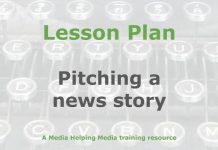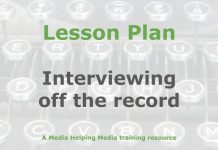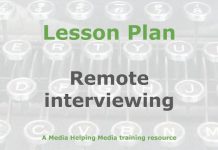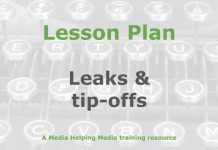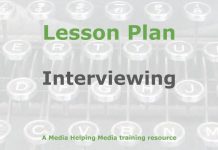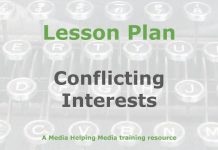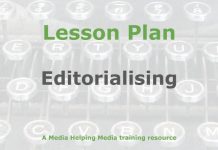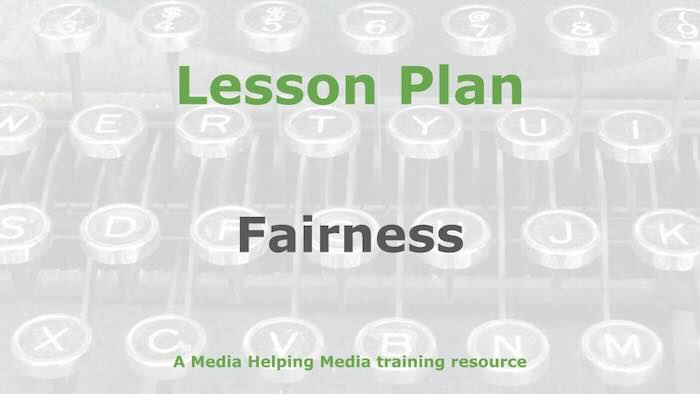 This lesson plan is designed to help students understand what it means to be fair when reporting and to consider all sides of a story and treat information gathered accurately.
This lesson plan is designed to help students understand what it means to be fair when reporting and to consider all sides of a story and treat information gathered accurately.
It’s based on the article Fairness in journalism which is published on Media Helping Media. We recommend trainers read the article before adapting this lesson plan for their own purposes.
Learning objective
Students will evaluate news articles to assess the fairness of reporting by examining multiple perspectives and verifying facts. They will also critique the language and tone used to ensure accurate representation of the facts.
- Student-facing objective: By the end of this lesson the student will be able to check if all sides of a story are covered and make sure the language used is fair and accurate.
- Standards: After this lesson a student will understand the importance of exploring all sides of an issue and reporting their findings accurately.
Learning activities
Warm-up
- Begin with a brief discussion on the concept of fairness. Ask students to think about a time when they felt a story or report was unfair or one-sided. Encourage them to share examples without naming specific media outlets.
- Next, present a simple, hypothetical news headline on the board. Ask students to brainstorm different perspectives that might be included in a fair report on the topic.
- Conclude by asking students to consider why it’s important to include multiple perspectives in journalism. This primes them for the lesson’s focus on fairness and balanced reporting.
Direct instruction
- Introduce main concepts: Explain the importance of fairness in journalism. Discuss how journalists must explore all sides of an issue and report findings accurately. Highlight the responsibility to avoid personal bias and ensure language and tone do not misrepresent facts. Use real-world examples, such as a recent news story, to illustrate these points.
- Analyse a news article: Provide students with a news article. Guide them through identifying potential bias and assessing the fairness of the reporting. Ask them to consider if all relevant perspectives are included and if the language used is neutral. Use questions like: “What perspectives are missing?” and “How does the language influence the reader’s perception?”
- Discuss right of reply and editorial independence: Explain the concept of the right of reply and its importance in fair reporting. Discuss editorial independence and the need to maintain control over content. Use a hypothetical scenario where a journalist must decide whether to include a response from a controversial figure. Encourage students to think critically about the ethical implications and the balance between public interest and fairness.
Guided practice
Think, Pair, Share: Guide students through a structured activity to practice identifying bias and assessing fairness in journalism.
- Think: Provide students with a short news article. Ask them to individually read and note any potential bias, missing perspectives, or language that may misrepresent facts.
- Pair: Have students pair up to discuss their findings. Encourage them to compare notes and identify any additional biases or perspectives they may have missed individually.
- Share: Facilitate a class discussion where pairs share their insights. Encourage students to articulate how they identified bias and assessed fairness. Highlight diverse viewpoints and ensure all students understand the importance of multiple perspectives.
- Reflect: Ask students to reflect on how their understanding of fairness in journalism has evolved through this activity. Encourage them to consider how they might apply these skills in evaluating future news articles.
- Feedback: Provide feedback on their analysis, focusing on their ability to identify bias and assess fairness. Reinforce the importance of these skills in responsible journalism.
Independent practice
- Article analysis: Assign students a news article to read independently. Instruct them to identify any unfairness, missing perspectives, or language that may misrepresent facts. Provide a worksheet with guiding questions to support their analysis.
- Reflection: Ask students to write a brief reflection on how the article could be improved for fairness. Encourage them to suggest additional perspectives or changes in language that would enhance the article’s balance.
- Peer review: Pair students to exchange their analyses and reflections. Have them provide constructive feedback to each other, focusing on the identification of bias and suggestions for improvement.
Circulate to observe and support students as needed.
Assignment
Ask students to answer these questions:
- How can a journalist ensure they are being fair when reporting a story?
- Why is it important to include multiple perspectives in a news article?
- What’s one question you still have from today’s lesson?
Here are some suggested answers:
- Suggested answer to Question 1: A journalist can ensure fairness by exploring all sides of an issue, verifying facts, and using neutral language.
- Suggested answer to Question 2: Including multiple perspectives ensures a balanced view and helps prevent bias, providing a more accurate representation of the facts.
Teacher resources
Differentiation guide
- Advanced learners: Encourage deeper analysis by having students compare multiple articles on the same topic from different sources. Ask them to evaluate the consistency of perspectives and language across these articles. Challenge them to identify subtle biases and discuss the potential impact on public perception.
- Striving learners: Simplify the task by providing a checklist of common biases and perspectives to look for in an article. Pair them with peers for collaborative analysis, allowing them to learn from others’ insights. Offer sentence starters to help them articulate their thoughts during discussions.
- Background reading: We recommend trainers read the article Fairness in journalism which is published on Media Helping Media before adapting this lesson plan for their own purposes.
Notable definitions
Fairness: Fairness in journalism is the concept of reporting news without bias or prejudice. It involves presenting all sides of an issue and reporting the facts accurately. Journalists should be objective and impartial, and they should not let their personal feelings or beliefs influence their reporting.
Bias: A tendency to present information in a way that reflects a particular perspective or preference, potentially leading to unfair or unbalanced reporting.
Right of reply: The opportunity given to individuals or groups to respond to allegations or criticisms made against them in a news report, ensuring fairness and balance.
Editorial independence: The freedom of journalists to report news without undue influence from external parties, allowing them to maintain objectivity and integrity in their reporting.
Required materials
- Copies of a news article for analysis
- Whiteboard and markers
- Worksheet with guiding questions for article analysis
- Access to computers or tablets (optional, for online article access)
- Reflection and peer review templates
Lesson summary
- Warm-up
- Direct instruction
- Guided practice
- Independent practice
- Assignment
The free teaching tools at the Khan Academy were used as a basis for converting the original article into a lesson plan.

